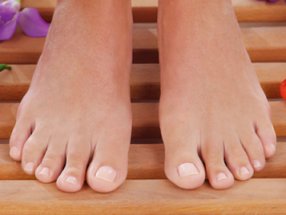
If you aren’t wearing the proper running shoes, you can damage your feet
Choosing running shoes for your foot type is vitally important. If you are running in the wrong type of shoe you may injure your feet and possibly your legs. Your post-run aching feet are probably an indication that you have not selected the right type of running shoe.
Injuries that runners can sustain because of the wrong pair of running shoes include plantar fasciitis, posterior tibialis syndrome, Achilles inflammation, stress fractures, knee pain and black toenails.
You must determine first and foremost if you have flat feet or a highly-arched foot. If you are not sure whether your feet are flat or high-arched do the wet test.
Get your feet wet and step on a paper towel or newspaper or stand on concrete. Look at your footprint. If you are flat footed, your wet foot imprint will show the entire bottom of your foot. There will not be any indentation where the arch is supposed to be because you do not have an arch.
When you are flat footed, you will over-pronate, which means that there is extreme inward rolling of your foot after your heels strike the ground. A flat-footed person will notice that the treads of his shoes show signs of wear by the big toe and on the inside. When choosing running shoes for your foot type, consider wearing motion control or high stability shoes to prevent the inward roll of your foot.
This type of foot is suited for motion control shoes and stability shoes because they have firm medial support and soles that are relatively flat, which well serve those who are over-pronators, whether you over-pronate moderately or severely so.
A medium arch or normal foot leaves a wet imprint of the heel and the forefoot connected by a wide band. When you have a neutral arch, this indicates that you do not over pronate or, if you do, it is only slight, which is perfectly normal.
This is a very common foot type and lends itself well to stability running shoes that consist of support devices, namely dual density mid-soles and medial posts, which are ideal for slight over-pronation. You are not in need of significant correction but your running shoes should provide moderate stability and some cushioning.
A foot that is high-arched will leave an imprint of the heel and the forefoot that is connected by a thin band. A high-arched person under-pronates or supinates.
A good shoe for this type of foot is a neutral cushioning shoe. These shoes do not have a medial post or stability devices and are softer in the midsole as well as offer more flexibility that does not hinder natural pronation. Your shoes will show signs of wear by the little toe and on the outside of the shoe. You need to wear new athletic shoes that are flexible to counteract your rigid feet and that are well cushioned.
Keep in mind when choosing running shoes for your foot type that motion control shoes are ideal for those of you with low or flat arches. These shoes have flatter and wider out-soles. If you are a large person, motion control shoes will give you the durability and support that you need.
Stability shoes are best for those with normal or medium arches and who slightly over-pronate.
High arched runners need to wear neutral cushioning shoes because this type of footwear provides extra shock absorption.
Trail shoes are for runners who like to run off-road. These shoes provide durability and good traction and are more water and weather resistant than other types of running shoes. Trail shoes are stiffer and provide stability when running on uneven terrain.
Resources:
LifeHacker: Identify your foot type before choosing running shoes
Runners’ World: Learn your foot type
